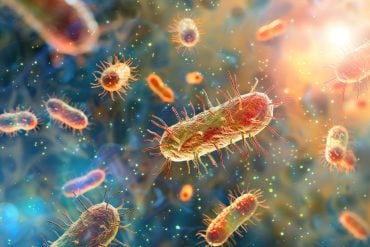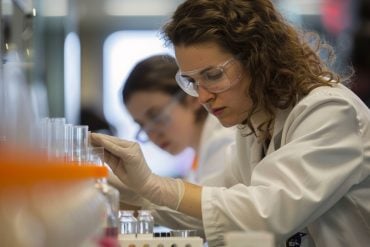Summary: Moderate physical activity was linked to increased volume in brain areas associated with memory, especially in older adults. Researchers say mild-to-moderate physical activity may have neuroprotective properties.
Source: DZNE
Exercise keeps body and mind healthy—but little is known about exactly how and where physical activity affects our brains.
“In previous research, the brain was usually considered as a whole,” says Fabienne Fox, neuroscientist and lead author of a current study.
“Our goal was to take a more detailed look at the brain and find out which regions of the brain physical activity impacts most.”
Extensive data from the Rhineland study
For their research, Fox and colleagues used data from the Rhineland Study, a large-scale population-based study conducted by DZNE in the Bonn city area. Specifically, they analyzed physical activity data from 2,550 volunteers aged 30 to 94 years, as well as brain images obtained by magnetic resonance imaging (MRI).
To sample physical activity, the study participants wore an accelerometer on their upper thigh for seven days. The MRI scans provided information particularly on brain volume and thickness of the cortex.
The more active, the greater the effects
“We were able to show that physical activity had a noticeable effect on almost all brain regions investigated. Generally, we can say that the higher and more intense the physical activity, the larger the brain regions were, either with regard to volume or cortical thickness,” Fabienne Fox summarizes the research results.
“In particular, we observed this in the hippocampus, which is considered the control center of memory. Larger brain volumes provide better protection against neurodegeneration than smaller ones.”
However, the dimensions of the brain regions do not increase linearly with physical activity. The research team found the largest, almost sudden volume increase when comparing inactive and only moderately physically active study participants—this was particularly evident in older individuals over the age of 70.
“In principle, this is very good news—especially for those who are reluctant to exercise,” says Ahmad Aziz, who heads the research group “Population and Clinical Neuroepidemiology” at DZNE.
“Our study results indicate that even small behavioral changes, such as walking 15 minutes a day or taking the stairs instead of the elevator, may have a substantial positive effect on the brain and potentially counteract age-related loss of brain matter and the development of neurodegenerative diseases. In particular, older adults can already profit from modest increases of low intensity physical activity.”
Young and somewhat athletic subjects who usually engaged in moderate to intense physical activity also had relatively high brain volumes. However, in even more active subjects, these brain regions were slightly larger. Also here it showed: the more active, the greater the effect, although at high levels of physical activity, the beneficial effects tended to level off.
Brain regions that benefit the most
To characterize the brain regions that benefited most from physical activity, the research team searched databases for genes that are particularly active in these brain areas.
“Mainly, these were genes that are essential for the functioning of mitochondria, the power plants of our cells,” says Fabienne Fox.
This means that there are particularly large numbers of mitochondria in these brain regions. Mitochondria provide our body with energy, for which they need a lot of oxygen.

“Compared to other brain regions, this requires increased blood flow. This is ensured particularly well during physical activity, which could explain why these brain regions benefit from exercise,” says Ahmad Aziz.
Exercise protects
The bioinformatic analysis further showed that there is a large overlap between genes whose expression is affected by physical activity and those that are impacted by neurodegenerative diseases such as Alzheimer’s, Parkinson’s, or Huntington’s disease.
This could offer a potential explanation for why physical activity has a neuroprotective effect, the research team concludes.
“With our study, we were able to characterize brain regions that benefit from physical activity to an unprecedented level of detail,” says Ahmad Aziz. “We hope our results will provide important leads for further research.”
And also approaches for everyday use: “With our results, we want to provide a further impetus to become more physically active—to promote brain health and prevent neurodegenerative diseases,” says Fabienne Fox. “Even modest physical activity can help. Thus, it’s just a small effort—but with a big impact.”
About this exercise and brain health research news
Author: Press Office
Source; DZNE
Contact: Press Office – DZNE
Image: The image is in the public domain
Original Research: Closed access.
“Association Between Accelerometer-Derived Physical Activity Measurements and Brain Structure: A Population-Based Cohort Study” by Fabienne A. U. Fox et al. Neurology
Abstract
Association Between Accelerometer-Derived Physical Activity Measurements and Brain Structure: A Population-Based Cohort Study
Background and Objectives:
While there is growing evidence that physical activity promotes neuronal health, studies examining the relation between physical activity and brain morphology remain inconclusive. We therefore examined whether objectively-quantified physical activity is related to brain volume, cortical thickness and grey matter density in a large cohort study. Additionally, we assessed molecular pathways that may underlie the effects of physical activity on brain morphology.
Methods:
We used cross-sectional baseline data from 2,550 eligible participants (57.6% women; mean age: 54.7 years, range: 30–94 years) of a prospective cohort study. Physical activity dose (metabolic equivalent hours and step counts) and intensity (sedentary, light-intensity and moderate-to-vigorous intensity activities) were recorded with accelerometers. Brain volumetric, grey matter density and cortical thickness measures were obtained from 3T MRI scans using FreeSurfer and Statistical Parametric Mapping. The relation of physical activity (independent variable) and brain structure (outcome) was examined with polynomial multivariable regression, while adjusting for age, sex, intracranial volume, education and smoking. Using gene expression profiles from the Allen Brain Atlas, we extracted molecular signatures associated with the effects of physical activity on brain morphology.
Results:
Physical activity dose and intensity were independently associated with larger brain volumes, grey matter density and cortical thickness of several brain regions. The effects of physical activity on brain volume were most pronounced at low physical activity quantities and differed between men and women and across age. For example, more time spent in moderate-to-vigorous intensity activities was associated with greater total grey matter volume, but the relation leveled off with more activity (standardized ß [95% confidence intervals]: 1.37 [0.35, 2.39] and -0.70 [-1.25, -0.15] for the linear and quadratic terms, respectively). The strongest effects of physical activity were observed in motor regions and cortical regions enriched for genes involved in mitochondrial respiration.
Discussion:
Our findings suggest that physical activity benefits brain health, with the strongest effects in motor regions and regions with a high oxidative demand. While young adults may particularly profit from additional high-intensity activities, older adults may already benefit from light-intensity activities. Physical activity and reduced sedentary time may be critical in the prevention of age-associated brain atrophy and neurodegenerative diseases.






